 |
|
 |
| |
Ads by Google, based on your browsing history
|
|
2021
May
29
|
COVID retreats

For more than a year, every day I've looked for the release of the day's
Georgia COVID numbers shortly after 2:50 p.m.,
in the hope that there would be good news. Above you see today's chart.
And you can see that after four waves of COVID (the fourth one weak in the U.S. though
strong elsewhere), COVID
finally seem to be retreating.
The national graph is similar to Georgia's.
The news is even better when you consider that (1) the
left edge of the graph, up to May 2020, reads low by a factor
of 2 or more because
there was relatively little testing back then,
and (2) the graph shows us how COVID was spreading a couple
of weeks ago, when today's patients were being exposed, so it has in fact gone down even more than the
graph shows.
(The graph seems to have flattened out just today, May 29, but that's because an exceptional number
of tests were reported today before the holiday. The percentage of tests coming back positive is the
lowest ever, 2.5%, compared to 30% in April 2020.)
With all this in mind, COVID in Georgia now seems to be at a lower level than when the pandemic was
first announced in March 2020, and this time it's going down more than exponentially.
That is, it's not just tapering
off, it's going down in a nearly straight line.
Vaccines made the difference, of course, along with the fact that a lot of the people who could get
COVID have gotten COVID and, if they survived, are immune or at least resistant. There has also always
been some evidence that some people are naturally resistant. Maybe the virus is running out of people to infect.
It's like a wildfire that's almost out. Let's not stop fighting it until it's gone!
Permanent link to this entry


|
2021
May
26
|
About fake and fantasy astrophotos
[Based on a Facebook posting.]
We've just had a lunar eclipse, and people are circulating pictures of it that are
obviously fake — the moon in front of clouds, even the moon in front of a building.
We astrophotographers rant about this a lot, and we usually talk about the scientific
value of astrophotos, and the ethical importance of not deceiving an audience, and above
all the importance of not cheating in competition with other astrophotographers
facing the same technical challenge.
But I don't think that quite covers it. What if the picture is presented as "art"
with no explicit claim to realism?
(1) If it's art, it needs to be good art.
I'll be the first to admit that non-realistic pictures can be good, even great, works of art.
But the artist needs to have something to say other than just "see how funny I can make this look."
I think that's one annoying thing about many "impossible" composite images —
they seem to show nothing but confusion on the part of the artist.
Far from sharing the real the beauty of the universe, that kind of artist scrambles it.
(2) Ultimately, what concerns us is respect for reality.
The sky is real; it's not fiction or fantasy.
After going to great effort to take pictures of (for example) an eclipse the way
it really looked, we feel uneasy when somebody, "for art's sake," has made it look completely different.
The audience may not be equipped to tell which is real and which is imaginary.
At the very least, they should be told. Reality should be respected.
Think of an artist who paints a picture of a fictitious naval battle.
Such an artist can really teach us something about ships and naval warfare,
even if the actual battle in the picture never happened.
But if the artist shows the ships doing things ships can't possibly do,
anyone who knows more about ships will dismiss the picture as nonsense.
And point (2) is why we do respect really good space art,
where the artist has worked out how to show us something that can't be seen from Earth.
Such images can be both enjoyable and valuable.
We also respect images that are pure fantasy and are not presented as real celestial phenomena
at all — such as science-fiction book covers.
Such pictures can be thrilling.
But they are not presented as "my photo of the May 26 eclipse."
Ultimately, it all comes back to truth vs. "post-truth."
Permanent link to this entry


|
2021
May
25
|
The post-stupidity era?
Based on a Facebook posting.
Something I should probably say at greater length, once I figure out how, but it needs to be said...
As life returns to normal, some of you are going to learn the hard way
that if you spent the past year showing off your foolishness,
people are going to think you're foolish.
If you spent the year spouting conspiracy theories, ranting nonsense, following QAnon,
advocating insurrection, or (most commonly) showing the world that you can't recognize
reliable information or don't even want to — you're going to find that people think less of you.
You can get away with things while sitting at home on social media
that you can't when you're in the real world.
On the job, can COVID-denying cranks be trusted to follow their employers' health and safety regulations?
If "nobody can make me wear a mask" can your employer
make you wear goggles or boots? If you follow cranks and disregard reliable information,
can someone recruit you into sabotaging your employer?
If you've been a big enough fool, you're unemployable.
Conservatism is not extremism.
Whether you're conservative or liberal,
please make a VERY sharp distinction between the conservative platform that got Trump
elected in 2016, and the strange things that have been done in Trump's name more recently.
It's a LONG way from a free-market economy to a man dressed as a buffalo invading the Senate.
You can defend one without defending the other.
One final point, hard to express.
I also think people who say wild things do not necessarily mean or believe them, deep down.
It's almost as if they were playing a game.
There is a strange disconnection between their words and the reality they actually act on
— most of the time — until they get caught up in a crowd.
The same is true of flat-earthers and of people suffering psychotic delusions.
And, like psychotic delusions, much of this wildness will go away, not by being refuted
(since it wasn't acquired rationally in the first place), but by losing salience.
That is, it will go away as people get their minds off it and spend more time
communicating with people who aren't deluded. But what's left behind will be plenty
to be ashamed of.
Permanent link to this entry
How to be a peacemaker
Based on a Facebook posting from a few years ago.
Preliminary thoughts on how to be a peacemaker:
(1) Peacemaking does not mean compromising with evil; if it did, Jesus wouldn't have told us to do it.
(2) Peacemaking does not mean giving up your objective sense of fairness, of right and wrong.
On the contrary, you have to have an outside standard of what solutions would and would not
be ethical.
(3) The two sides are probably not wanting exactly opposite things.
Their wants are incompatible but not diametrically opposed. That is usually the key to finding a solution.
(See also this.)
(4) Like a judge, you have to hear (and think of) the best that can be said for both sides;
this doesn't imply that both are right, only that you want to understand them.
You may be able to devise a better defense of one or both positions than the people who are defending them.
When you do, you'll be able to point out what they're thinking but not able to put into words.
(5) You have to get into the heads of both sides, understand what it is like to be a person on
each side of the conflict.
(6) You have to have some idea what success looks like.
Often, neither side in the conflict has a clear idea of what peace would be like.
You have to supply that.
Permanent link to this entry


|
2021
May
24
(Extra)
|
The Oglethorpe Yew
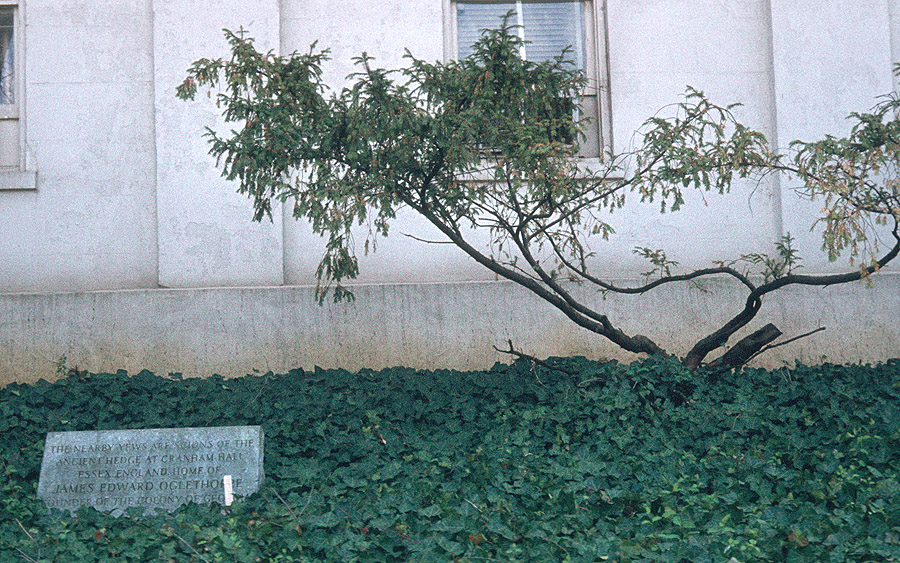
On the day Melody and I met, one of the things I did was lead a campus tour, and she joined
my tour group. I decided to share with Melody, and with the whole group, a historical detail
of the University that I had noticed, but which nobody ever talked about:
the Oglethorpe Yew.
In the flowerbed between Academic Building and Broad Street was a sign:
THE NEARBY YEWS ARE SCIONS OF THE
ANCIENT HEDGE AT CRANHAM HALL
ESSEX ENGLAND HOME OF
JAMES EDWARD OGLETHORPE
FOUNDER OF THE COLONY OF GEORGIA
accompanied by at least one yew tree, which you see in the picture above,
taken in 1975. I thought there were other smaller ones, but they may have
been other shrubbery. The connection both with England and with 18th-century
Georgia excited me.
The other day I walked by the same place and noticed that the yew tree was
no longer there, though the sign still was.
I contacted the University and learned that the Oglethorpe Yew, as they called it,
died a couple of years ago, but cuttings from it have been taken to a greenhouse
in the hope of growing a replacement. Long may they live.
Permanent link to this entry


|
2021
May
24
|
Windows Night Light saves astronomers' night vision
When using a computer at the telescope, we need to preserve our night vision,
and if other astronomers are working nearby, it's very important not to make
them lose their night vision.
Accordingly, many of us put red acrylic plastic or Rubylith over our screens.
The disadvantage is that the filtering is so strong that blue and green objects
on the screen are completely invisible.
There have been various software approaches, but now Windows has one built in.
Click on the notification button and you'll see a button for Night Light.
Click it to turn Night Light on and off, or right-click on it to get to its
settings. If it's set to its maximum strength, it's nearly as good as a red
filter, particularly if you turn down the brightness.

For a similar software-based solution for the iPhone,
click here.
Permanent link to this entry
Stellarium, iOptron, and how I missed seeing a menu
[NOTE ADDED JULY 2021:] NOT A SOLVED PROBLEM.
Although the configuration shown below is correct, I cannot get reliable operation.
Often, Stellarium sticks at "Connecting" rather than "Connected" or even hangs.
Some of the time, Stellarium will show the telescope's position but hangs when
told to slew the telescope. Cartes du Ciel works fine.
Ever since I got the iOptron mount, I had been trying to get it to work with
Stellarium (excellent, free star map software), and last night I finally got
it working.
I finally got the map to show me where the telescope was aimed, and got
the telescope to go to whatever I pointed out on the map.
The step I was missing was rather silly.
Here's what has to be installed on the computer:
That's what I already had, but when I told Stellarium to connect to the telescope, it never did.
Silly me... there was another menu I hadn't seen! After telling Stellarium to use ASCOM to control
the telescope, I was also supposed to scroll down to another hidden menu and tell ASCOM what
telescope driver to use.
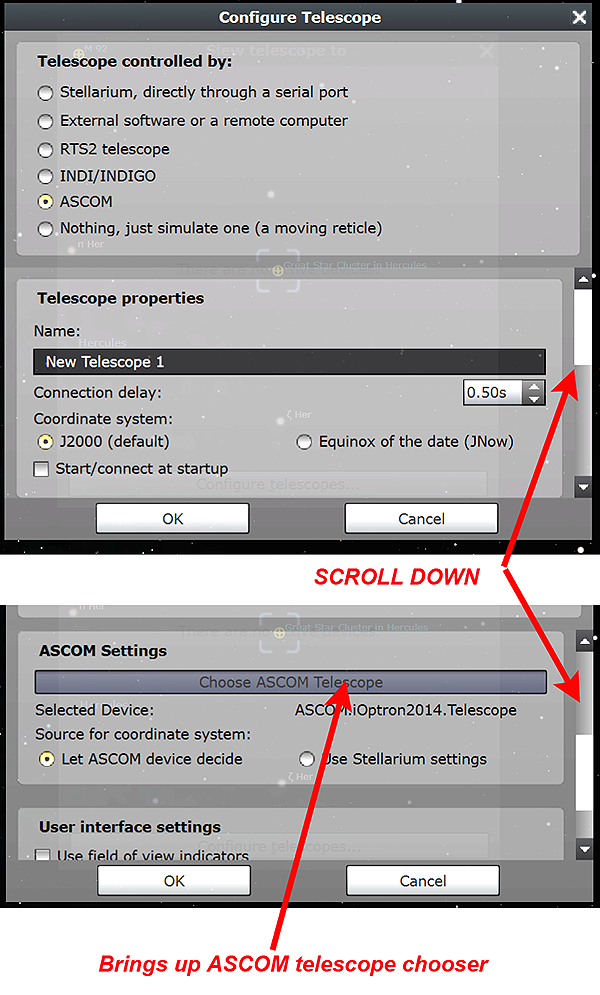
Apparently I'm not alone. In online forums, it looks like a substantial number of iOptron-and-Stellarium
users miss this step.
As a software designer, I have two thoughts:
- Trying to connect to ASCOM without having chosen a telescope driver is an error situation
and should cause a message to pop up.
- Hiding a menu where it can be overlooked is bad form.
But I want to thank the authors of the Stellarium Telescope Control plugin and encourage them
to continue their valuable work.
A separate issue: To keep the screen of the ThinkPad T490 from going black momentarily when Telescope
Control menus came up, I had to launch it with the "ANGLE Mode" shortcut rather than the regular one.
This uses a simpler way of accessing the graphics system.
Permanent link to this entry


|
2021
May
23
|
Little or no sound with external microphone
Computer has a Realtek audio driver
Microphone level settings and boost are not sufficient
NOTE: This problem was cured by the Windows 21H1 update.
I am leaving this entry in place in case others have similar problems
and can't solve them that way.
Problem:
Today I got a pair of earbuds with a microphone, plugged them into my ThinkPad P17, and
found the microphone picking up almost no sound. Everything recorded with it was very
quiet or silent.
I went to Control Panel, Sound, Recording devices, picked the microphone,
and chose Levels and turned everything all the way up (including 20 dB of boost).
That had some effect but wasn't enough.
Solution: Change the audio driver from Realtek to Microsoft High Definition Audio.
(Warning: Windows Update will probably undo this eventually; be prepared to
do it again. Or maybe Realtek will come out with an update that works correctly!)
Steps:
Hold down Window and hit X. Choose Device Manager. Find your Realtek audio device, right-click
on it, then choose
Update Driver, Browse my computer, Let me pick, and uncheck Show Compatible Hardware.
Here's where you're heading:

You will find that this Microsoft driver works correctly with your microphone.
You will still probably need to set some boost in Control Panel, but at least when you do so,
it will have the intended effect.
Permanent link to this entry
Computers do make mistakes
What happened here?

I'm guessing somebody represented the price as a binary floating-point number instead of a decimal number.
Recall that 1/3 has no exact decimal representation (0.3 is close, 0.3333 is closer, 0.3333333 still isn't there).
Similarly, 1/100 (that is, one cent) has no exact representation in binary (base 2).
Correct practice in business software is to use internal decimal representation, or if that is not
available, a whole number of cents, because integers don't have this problem.
Sharing this on Facebook, several of us joked about the 0.0000000000005-cent coin that would be
needed to make change. I postulated that it traditionally consisted of a single atom of silver,
but nowadays was a copper-nickel alloy, and it was unpredictable whether you'd get copper or nickel,
and coin collectors with electron microscopes were following the issue with interest.
Someone else said I had "won the Internet" for the best whimsy of the day.
Permanent link to this entry
50 years ago this month
Amid the important 45th anniversaries, I let a couple of 50th anniversaries go by.
I was doing interesting things as a ninth-grader in 1971.
On May 3, I attended one day of the "Week of Seminars" at Valdosta State College.
These were public lectures by faculty members.
There was a similar event a year later, and maybe even two years later,
and I'm no longer sure which seminars were
in which year, but among them were a planetarium show, a dramatization in which Dr. Louis
Schmier played Plato, and a lecture about Castro by Dr. José Fernández (Spanish-language mentor
to the Action Trav'lers, about whom more later, and to me). There was also an economics
talk (in 1972, I think) from which I carried away the important concept that unemployment
does not normally go below 4% because some people are deliberately changing jobs at any
given time. And one of these seminars, in 1972, was the last time I saw a legendary Valdostan,
Colonel Wesley Ren Christie, who had been our next-door neighbor on
Dellwood Drive and who had unwittingly launched my linguistics career by giving me
a Bell Labs educational kit about speech synthesis.
On May 16 I did something more prosaic, but interesting: got up at 5 a.m. and set up my
telescope to watch the moon pass in front of Mars. I observed it only as celestial scenery,
but in the past, observations of this type have been useful for establish exact positions
of objects in the solar system (by timing them), and also for establishing that the moon
does not have an atmosphere (because we'd see it against the planet farther away).
Permanent link to this entry


|
2021
May
21
(Extra)
|
45 years ago today:
A historic dinner in Winder
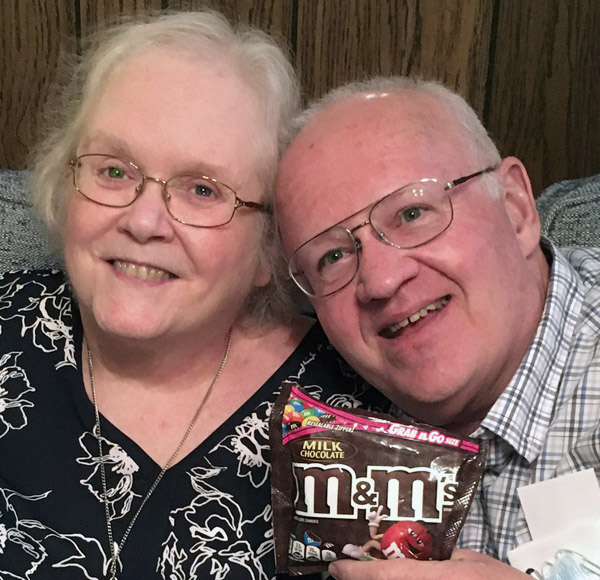
"M and M" in 2021, with eponymous candy.
This evening, Melody, Sharon, and I went to have dinner with Melody's mother in Winder,
to commemorate the 45th anniversary of the first time the family had me over to dinner,
in the same house, on May 21, 1976. We brought take-out food from Longhorns, and Melody's
mother presented us with a packet of M&M's, since we are, of course, M and M.
I said grace, as follows: "Blessed art thou, Lord our God, who hast enabled us to
reach this day. Thank you, Lord, for this house, and for this family, and for
creating Melody and bringing us together and sustaining us all these years."
May 21, 1976, was one of the most important days of my life.
On that day, Melody and I started out as best friends, but by the end of it, we
were much more than that.
This was the dinner that I needed to go to in order to get Melody's parents' permission
to date her. (She was 17 and still in high school.)
The purpose was obviously to give me a good welcome if I turned out to be as
good as Melody claimed, and to get rid of me if I didn't.
I acknowledge that in those days, when most people heard what I was really like,
they simply didn't believe it.
Here was an 18-year-old young man who knew Latin and Greek and about four other languages,
had a working knowledge of the sciences and also classical and English literature,
had a job programming computers (rare in 1976),
was a solid Christian very active in the church,
and had recently been sent around the world by the President of the United States.
Real? Who could tell? Yes, it was all real.
OK, then, was I a popular big-man-on-campus toying with a
high-school girl who wouldn't know what else he was up to?
No; I really had no girlfriend but Melody, the object of my adoration.
But I don't blame her family for wanting to get to know me a little better
before coming to a conclusion.
The dinner went well, and by the end of the evening, Melody and I were inseparable.
But our courtship went slowly. We were young, and I had years of graduate school
ahead of me. I am deeply grateful to Melody for never asking me to cut short my
studies. I went and got my Ph.D., married Melody, and we lived happily ever after!
Our first date in the full sense of the word
(in the evening) was just four days later, on May 25;
I took her to see an adaptation of Godspell presented as a fund-raising
dinner theatre at the Baptist Center.
It established our standard double-round-trip itinerary, where I drove from Athens
to Winder, brought her back to Athens for our date, then took back to Winder,
then came home. This isn't as much driving as it sounds like.
The route, through Bogart and Statham, became very familiar
(and we followed it this evening for the commemorative trip even
though Highway 316 is now preferable).
I will note a few more 45th anniversaries as they come up.
Footnote: My Jewish friends will recognize in my prayer an echo
of the Shehecheyanu,
which has always been one of my favorite prayers.
Permanent link to this entry


|
2021
May
21
|
Craters and craterlets
Last night (May 20) I set up my telescope and quickly tested out all its connections to the
new, small laptop (ThinkPad T490). For deep-sky work I did not actually take any pictures,
just tried out the autoguider. But I did do some lunar imaging.
The air wasn't steady, but the moon was high overhead, and I got reasonably
sharp pictures.
Here's the great crater Copernicus and a field of craterlets to the upper right
(lunar northeast):
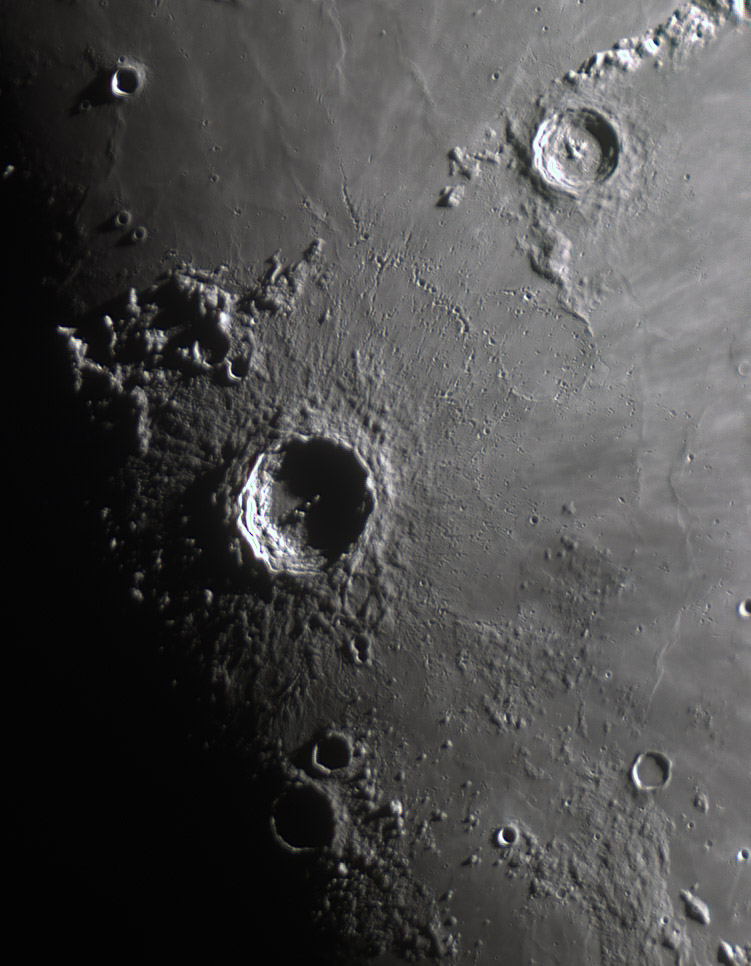
And here are the craters Tycho, Clavius, and many others:
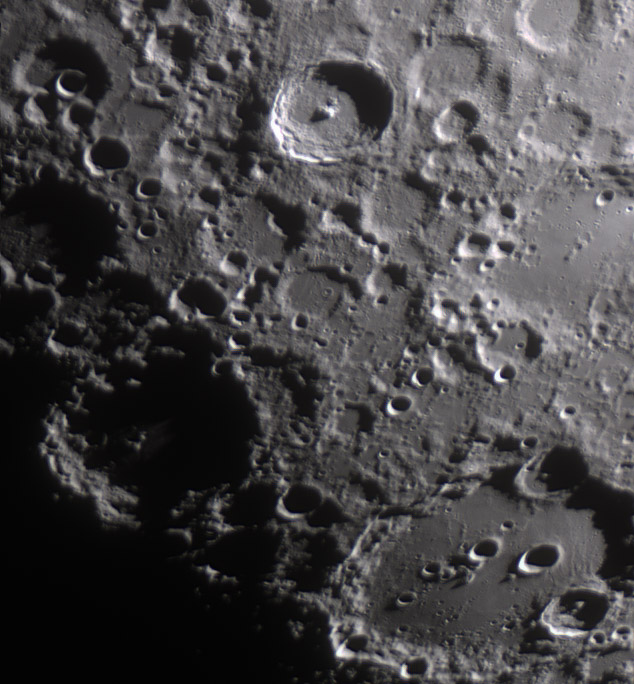
Each of these is a stack of the best 20% of thousands of video frames, taken over the course of a few
minutes with my Celestron 8 EdgeHD (at f/10) and ASI120MM-C camera.
Permanent link to this entry


|
2021
May
20
|
What I think about UFOs
The U.S. Government is soon going to release a report on unidentified flying objects (UFOs)
and (nearly the same thing) unidentified aerial phenomena (UAPs).
Everybody's asking me what I think. Well, here goes.
These are my considered opinions, but I don't have any inside information.
Unidentified, yes. Space aliens, no.
I think it extremely unlikely that we're being visited by intelligent beings
from other planets. The reason is, there is nowhere for them to come from.
Back in the 1950s, many well-informed people still believed Mars might be inhabited.
We now know it isn't. There can't be any intelligent life at less than interstellar
distances. The nearest possibility is Proxima Centauri, which does have a system of
planets, slightly more than 4 light-years from us. That doesn't mean you could get
here from there in 4 years. Accelerating to even 1/100 that speed, then decelerating
to visit us, would require an
enormous amount of energy.
Yes, please report and track them. I think the government should be tracking UFOs and UAPs
and informing the public. The reason is, this is a great way to learn about:
- Other countries' aerospace technology, including things we would not have guessed,
some of which might be space weapons. (Project Blue Book was canned when it was about
to blow the cover on some of our own high-altitude experiments.)
- Undiscovered atmospheric and astronomical phenomena. There's no reason to assume
we know about everything that can be visible from earth.
- Undiscovered aspects of human vision and psychology. There may well be optical
illusions we don't know much about yet. And my own experience confirms that inexperienced
observers can give wildly unrealistic descriptions of simple, well-known things, especially
when they latch on to a misinterpretation and won't let go of it, or they don't know the
limits of their own eyes.
People are gullible about the wrong things. Why are so many people eager to believe
everything they've seen on Star Trek
(including the warp drive and the transporter, which are pure fiction)
but unable to believe there are undiscovered
or poorly-understood visual illusions? Or unable to believe that sometimes, convincing words
come from people who are self-deceived or deliberately lying?
A related point is that pilots are biased to interpret everything unexplained as an aircraft.
Their lives can depend on recognizing aircraft that are barely visible.
Astronomers, on the other hand, never see UFOs — but then, they are biased to ignore
anything that looks like aircraft or satellites.
People also forget that satellites and "space junk" are tracked.
If NASA can keep track of every 4-foot piece of scrap metal that is in low earth orbit,
you might expect them to detect alien vehicles passing through the same space.
Somehow, they never do.
Finally, skepticism is the right attitude. Even if I believed in space aliens, I would be
grateful to UFO skeptics for weeding out the overwhelming number of cases that aren't
what we're looking for.
See also
this.
Permanent link to this entry


|
2021
May
16
|
Gadget of the day (plus 2 new laptops)

What you see here is the gadget that people really need right now but will
not need so urgently a few months from now.
It is an adapter with a USB-C plug and a USB-A socket.
It lets you plug conventional USB devices into newfangled USB-C ports.
With USB 3.1 performance, of course.
I bought a couple of these because I have 2 new laptops, and on them, USB-C ports are
proliferating, but USB-C cables and USB-C flash drives are not yet common.
Click on the picture to buy one of your own.
My old laptop had a USB-C port which I had never used. One of the new
ones, a ThinkPad T490, has two conventional (USB-A) USB 3.1 ports and two USB-C ports
— through either of which the laptop can be charged! That's right, there's no
separate power input. Any USB-C PD 2.0 charger will work. That's going to make it easy
to get a 12-volt charger for when I use the T490 at the telescope. The other new
laptop, a ThinkPad P17,
has USB ports of both kinds, but it doesn't charge through them.
Compared to the older Lenovo and Asus computers I'm replacing, these ThinkPads are unusually
ruggedly built, have very comfortable keyboards, and offer great battery life.
They have high-resolution screens, and their video systems are able to drive screens much
bigger (in pixels) than just what they have built in. At FormFree, we are supplied large
monitors to plug into our laptops. These laptops can put them to good use.
ThinkPads have the Ctrl and Fn keys swapped compared to all others, but they can be
swapped back in BIOS, and I have done that and relabeled them. I wish Lenovo would
offer replacement key caps.
The P17 is a 17-inch, 8-pound monster, my computing powerhouse for image processing,
video editing, and AI. It's the one I currently carry to work, but the 14-inch T490 may take
its place since it's so much lighter (2 pounds). It's going to be the one I use traveling
and for telescope control. Both have Windows Pro (not Home), so I can RDP into them —
this will be particularly handy when the T490 is guiding an astrophoto and I want to check
on it from inside the house.
The desktop computer upstairs at which I've done most of my work for the past fourteen
months will settle back into a lesser role as a file server.
Permanent link to this entry


|
2021
May
14
|
Galaxies!
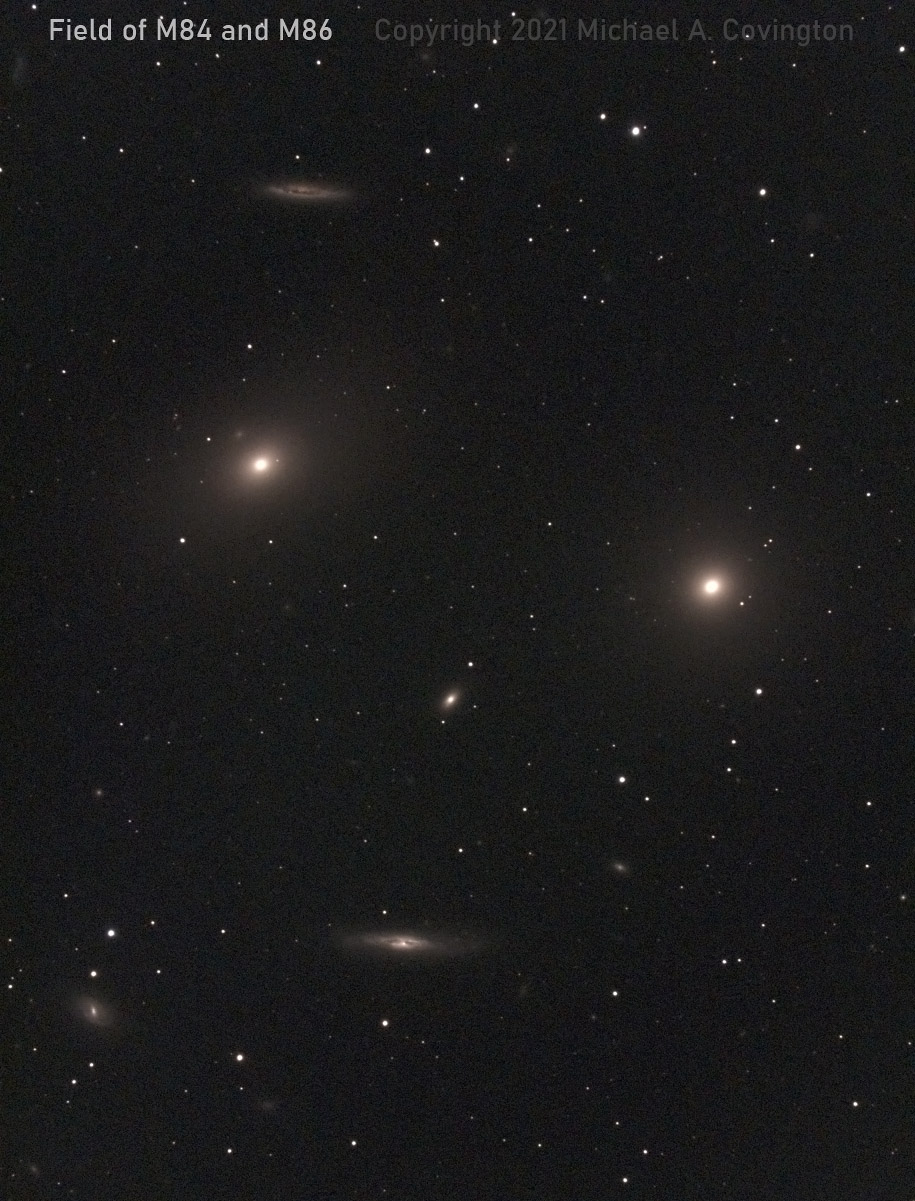
Last night (May 13) I got out my Celestron 8 EdgeHD with f/7 reducer and put it on the
newly repaired iOptron GEM45, with a Nikon D5500 (H-alpha modified) camera, a guidescope,
a guide camera, and autoguiding software. I did this with some trepidation because weather
radar showed rain as close as Dahlonega, though our sky remained clear.
Everything worked well. What you see above is a stack of 13 2-minute exposures at
ISO 200. Actually, I took 19, and all of them were well guided, but one was traversed
by an airplane, one by a meteor (!), and four more were not quite as well guided
as the rest, so, since I had plenty, I didn't use them.
The two bright galaxies are M86 (left) and M84 (right). In the center is NGC 4387; below it,
NGC 4388. At the very top is NGC 4402; at the bottom left, NGC 4413. You can see that
some of these are elliptical galaxies, relatively uniform blobs, while others are flattened
and (whether or not you can see it from this angle) have spiral structure.
Quite a few fainter galaxies are also visible.
At the extreme upper left corner is IC 355 (magnitude 14.9),
and at the extreme lower left corner, a little-known 15th-magnitude
galaxy known as LEDA
40723 (a catalogue I had never heard of).
As it was in the 1800s, but not in most of the 1900s,
modern amateur astronomy has access to objects not well known to science.
As of today I am allowed in University of Georgia buildings
without a mask. I haven't exercised that privilege yet, but it will
be good to go to the library.
Permanent link to this entry


|
2021
May
13
|
Have we lived through it?
Part of my daily routine for more than a year has been checking every day,
around 3 p.m., for new data on the web site
https://dph.georgia.gov/covid-19-daily-status-report
for the daily Georgia COVID status report.
Each day, I see a graph like this:

The two dark-colored counties appear to be artifacts of low
population, not genuine hot spots.
Look at how the infection rate has dropped.
There's more good news than this graph shows:
the percentage of tests that come back positive is way down,
and so is the death rate.
That means the early numbers (more than a year ago) were artificially low
on this graph, and the recent numbers aren't.
We're doing better than it looks.
There is finally good reason to believe that the dreaded fourth wave didn't hit Georgia,
and that it's fading in places it did hit (Michigan and even India), and that the cause
is a combination of factors: some people are vaccinated, some have already had COVID
(possibly without knowing it), and some are naturally resistant. The virus is
running out of people to infect. Not only that, but the risk of serious illness is
far less because better treatments are available.
I don't think the pandemic is over, but we're in the endgame, and our main goal now
is not to let it flare back up.
The CDC now says fully vaccinated people need not wear masks in most settings,
indoors and out, unless a large number of strangers are close together (as in a bus)
or there are sick people around (as in a doctor's office).
Of course, it is up to individual property owners and institutions to change their rules,
and as long as a lot of people resist vaccination, they would be wise to stay cautious.
I will be glad to be allowed into UGA libraries without a mask.
No change has been announced, but in a few days, the Spring 2021 students will
all be gone, and it will be a good time to make a change. I'm hoping.
I'm enjoying the new freedom to move around, but life threatens to become a frenzy of
activity. Today Melody took Sharon to a doctor's appointment, then took herself to get
massage therapy, then went with me to pick up groceries. Myself, I went to FormFree
before lunch, proceeded to the UGA campus for a walk and to buy a calculator at the
bookstore, and came home to deal with a flurry of phone calls and messages.
Now it's time to do everything!
Permanent link to this entry


|
2021
May
12
|
Getting out of the house
We've had a rather sudden paradigm shift as the benefits of vaccination are
accompanied by loosening of restrictions around us.
I've been working at the new FormFree building every weekday since last Wednesday
(today will be day 6). Yesterday, before work, I had lunch with Brantley
Coile, my second meal in a restaurant since the lockdown started; after leaving the FormFree
building late in the afternoon, I went to the UGA campus, parked in deck S11 as of old, did my
traditional walk for the first time in 14 months, and wandered around the Science Library
briefly, but because it was the last day of exams, the library was almost unoccupied.
We are still getting out a good bit less than we would if there were no pandemic, but Melody
is finally able to run a lot of errands. It is only by happenstance that I didn't get to church
on Sunday.
And the world into which we are re-emerging is not the one we left behind.
We ourselves are different — I have quite different work habits after a year of
working at home, and my job itself has changed.
It remains to be seen what postwar life is going to be like, but it's
not going to be a return to 2019.
Permanent link to this entry


|
2021
May
9
|
Inflation?
Quite a few economists are predicting inflation now, not only because of monetary
factors, but also because of genuine shortages of goods, services, and labor.
The economy is changing gears; a different set of businesses is growing; and we
don't have enough of what we now need.
In connection with the recovery from the 2008 recession, I predicted inflation a
few times when it didn't actually materialize (but others were predicting it too).
So, with appropriate humility, I am not offering a prediction now.
What I can do is tell you how to prepare for it.
- Pay off debts that have variable interest rates. Those rates will go up.
- If you have debts at fixed, low rates, such as a 2.5% mortgage, keep them.
You will pay them off in smaller dollars later. It works to your advantage to
keep a debt if its interest rate is lower than the rate of inflation.
- You're better off owning a house than renting. (But the real estate market
is in a feeding frenzy right now; you may not be able to make the change.)
- Don't keep large amounts of money in savings accounts.
The interest doesn't cover what you're losing from inflation. Invest in the
stock market, mutual funds, index funds, or most importantly, in paying off
your own variable-interest-rate or high-interest-rate debts.
- Make sure your salary keeps up with inflation, as best you can.
Many employers have gotten used to never giving inflationary pay raises.
They're going to need to start doing it.
I also want to caution against two kinds of folly.
Back in the 1970s, encouraged by shallow news reporting, too many people blamed
retailers for inflation — as if they were raising prices out of the blue.
No; they were passing along what they had to; and if they didn't, they couldn't
stay in business. When a retailer sells you something, he has to cover the
wholesale cost of the next item he'll put on his shelf to replace it,
not just what he paid for the one you're actually buying.
The other folly is using the term (and sometimes the concept) "hyperinflation"
when inflation is just a few percent. That is not hyperinflation.
And no, your money is not going to be worthless like happened in Hungary and
Zimbabwe. For that to happen, you more or less have to have a worthless economy,
not just a high inflation rate. And if you think our economy is worthless,
you're sitting around imagining things; you should get out more.
Permanent link to this entry


|
2021
May
8
|
Dropping things on strangers from space
Late this evening, a Chinese rocket booster stage will fall to earth in an
uncontrolled re-entry. It will probably land in the ocean, and if it
does not, it will probably hit an unpopulated area.
But probably isn't good enough. Dropping objects that can do serious
damage in random, uncontrolled places is, in my opinion, not acceptable.
It's like firing a single bullet into a large crowd and then boasting
that 59,999 out of 60,000 people were still safe.
The vast majority of man-made objects in space are not dangerous if they de-orbit.
They will burn up during re-entry or can be de-orbited to a controlled location.
Only rare, large, tough objects are able to reach the earth's surface and do damage.
This rocket stage is one of them, and it should never have been allowed to re-enter
uncontrolled.
In my opinion, allowing an uncontrolled re-entry of such an object is an act of,
at best, recklessness, and should be viewed as an attack on the country where damage
is done. Indeed, it could even be a smokescreen for a genuine space-based military attack, or a
way to keep such an attack from drawing immediate retaliation.
Don't drop space junk on strangers. Ever. It is not acceptable. Large objects that must
be launched into space should be required to have a mechanism for controlled re-entry and/or
a way to break them up into objects small enough to burn up.
[Update:] The Chinese rocket booster fell in the Indian Ocean.
Our own Skylab, in 1979, wasn't so lucky; fortunately it landed in a friendly
country (Australia) rather than a hostile one, but it came perilously
close to hurting people. Many large pieces were found in outdoor areas that
people frequented.
Permanent link to this entry


|
2021
May
7
|
Postwar life begins
[Updated.]
Georgia's COVID numbers are again going down steadily if slowly,
vaccines are taking hold,
and unless there's another serious surge (which is possible), we are
seeing the beginning of the post-pandemic era.
We figure we are 200× safer than at the peak of the second wave in January.
That's a factor of 20 from the vaccine and 10 from the decline of the epidemic itself.
Just as with a wildfire, though, we don't want people to stop fighting it before it's
actually out. It could flare back up again.
Normal life is resuming, with caution. In stores and other public indoor
spaces, we still wear masks. But I went to church last Sunday; have worked
in FormFree's new office building for three days in succession (and plan to
work there every weekday from here on); and today Melody went grocery shopping,
herself, for the first time in about fourteen months.
We are of course fully vaccinated. My UGA colleague Mark Ebell, M.D., suggests
that I'm safe if any two of the following five criteria are met:
- Everyone present is masked, and/or
- People are at least 6 feet apart, and/or
- Everyone is outdoors, and/or
- I'm vaccinated, and/or
- Everyone else is vaccinated too.
I have #4 all the time, so any one of the others is sufficient.
#1 is for the grocery store, #2 and usually #5 apply to the FormFree office,
#3 is for walks outside, and #5 is for the gathering we are going to
have on Mother's Day. [Which we can't go to after all;
Melody came down with a stomach ailment, apparently not related to COVID,
but she doesn't want to share it.]
I continue to hear whining from people who don't think vaccination should be a
condition for anything they do. They forgot that they had to have vaccines as
children in order to go to school. Some people are yelping about how colleges want
to require the COVID vaccination, forgetting that they already require measles and
other vaccinations for incoming students, and have done so for a long time.
I think some people just like to whine.
What is postwar life like? Prosperous but awkward as far as the economy
goes. We are finding strange shortages in stores. I went to Best Buy for SD cards
this afternoon and found four racks of them in different places, each rack at least
80% empty. The store looks full and prosperous but has been "dumbed down" toward
kitchen appliances and even toys rather than computers and technology. The Kroger
grocery store has strange gaps, such as a shortage of bottled water today.
And a lot of automobile drivers are obviously out of practice! Two nearly ran
over me in a pedestrian crossing in front of FormFree's office. Two oncoming
vehicles had politely stopped in the right places, and two more charged at me
as if I couldn't possibly be there, forcing me to jump back. Unkind, uncouth,
and uncalled-for.
But, as I said, this is the beginning of the postwar or rather post-pandemic era.
Just like the awkwardness right after WWII, it inaugurates a time when a lot of
little things will be different.
My old friend, computer-vision expert Margaret Fleck, defined a boundary as a
simultaneous small change in many attributes rather than a large change in one.
That's what we're having.
Permanent link to this entry


|
2021
May
5
|
Moan...
This afternoon I was heading out with a shopping list of 2 items:
9-volt batteries and, oddly, powdered sulfur to try to use as a snake
repellent in the yard.
Batteries and sulfur.
Or, as Melody summed it up, "Fire and brimstone."
We both doubled over laughing.
Permanent link to this entry


|
2021
May
4
|
First day back in the office
This afternoon I worked a couple of hours at the new FormFree office. Much was accomplished,
especially because I could talk face-to-face with two of the company's top leaders.
The last day of work in the old office was March 11, 2020.
Georgia's COVID infection rate is very slowly diminishing, often flat for days at a time.
At least it isn't shooting back up.
Permanent link to this entry


|
2021
May
2
|
Two milestones
Today is the 10th anniversary of my first hour of consulting for FormFree.
Almost nobody at FormFree has had a 10th anniversary.
We're a young company.
Today, also, I went to church for the first time since the lockdown.
To my surprise, relatively few people were wearing masks.
It's good to get back to normal, but I'm still a bit concerned about the masks.
Other precautions (distancing, sanitation) were abundant.
Melody stayed home because she still has higher health risks.
Permanent link to this entry
Enough graduations for a platoon
In today's service, high-school and college graduates were recognized, and the preacher
started to reminisce about his own graduations, starting with kindergarten.
That led me to make a list of my own. There were more than you could guess.
Here are my graduations and degrees, from birth to Ph.D.:
- 1963: Kindergarten. Graduation program here.
- 1968: End of elementary school (Sallas-Mahone, Valdosta, Ga.) at the end of sixth grade. As I recall,
this was an informal observance at the classroom level, but we got certificates (with names typewritten).
- 1970: End of elementary school again, in a school system that reckons it differently
(St. John School, Valdosta). This was a late-afternoon ceremony with a Catholic Mass, and
we got diplomas.
- 1974: High school (Valwood). Because my final year was entirely in absentia (it was also my
freshman year at UGA), I attended and got a diploma but was not eligible for any awards or recognitions.
Blue cap and gown, "disposable" but I think I
still have them.
- 1977: B.A., University of Georgia. Rather a big deal, as I was co-valedictorian and spoke at the
ceremony. This was also the last graduation ceremony of my own that I actually attended.
- 1978: M.Phil., Cambridge. Diploma came in the mail.
- 1980: M.A., Yale. Diploma came in the mail, unexpectedly.
Yale gives two levels of master's degrees on the way to the Ph.D., and
this was one of them.
- 1981: M.Phil., Yale. Again, diploma came in the mail, unexpectedly.
- 1982: Ph.D., Yale. Rather than go back to New Haven with family, I opted not to attend graduation,
and the diploma came in the mail.
Now you know. Check your mail carefully; you might end up educated!
Permanent link to this entry


|
2021
May
1
|
45 years ago today:
Melody, pizza, and computers
Today is the 45th anniversary of Melody's and my second prearranged meeting,
and just to confuse you, we celebrated it by re-enacting our first date,
whose 45th anniversary was
3 days ago.
The re-enactment consisted of going to the new
Georgia Museum of Art
and seeing some of the same pictures we saw on our first date.
We were welcomed to the museum by Michael
Lachowski, who had been Melody's classmate in art school (I think I recognized him) and went
on to become a noted musician.
Highlights of the visit included seeing the Samuel F. B. Morse portrait of Mrs. Munro,
and also La Confidence and several other pictures we remembered from the old days,
as well as the Nadler collection of Coptic art, including a little ivory sculpture of
Aphrodite that looked (to me) like it had stepped out of a 1950s magazine, complete with facial
expression and hairdo.

Here we are in front of La Confidence.
Picture by Michael Lachowski, used by permission.
On Saturday, May 1, 1976, Melody was on campus for Spring Visitation Day (for incoming
students) and we arranged to meet again.
The way I entertained her was something that would have been perfectly normal five
or even two years later, but was rare in 1976: we played with computers!
Not games, but a demonstration of BASIC programming, which was exciting enough.
Recall that 1977 was the year that Apple and others burst on the world with
practical home computers. In 1976, this had not yet happened, and we connected
to mainframe computers through terminals (keyboards with screens) over telephone lines.
From my journal:
So by then we were more than best friends. We were going to start dating, but
since she was still in high school, I needed her parents' blessing, hence the dinner,
which ended up being the evening meal on Friday, May 21.
For those who are reading this for the
background rather than the love story, I should fill in some things.
P-J Plaza comprises the Psychology and Journalism buildings (an Orwellian combination?)
and a couple of auditoriums, all sharing a red, and formerly very slippery, outside floor.
Fortunately, in the mid-1970s, before 1976, it was given a non-skid coating. You can see
in the picture below that the main floor of the Journalism building has a corridor around
its periphery, with windows, enabling me to take refuge from the rain and watch for Melody.
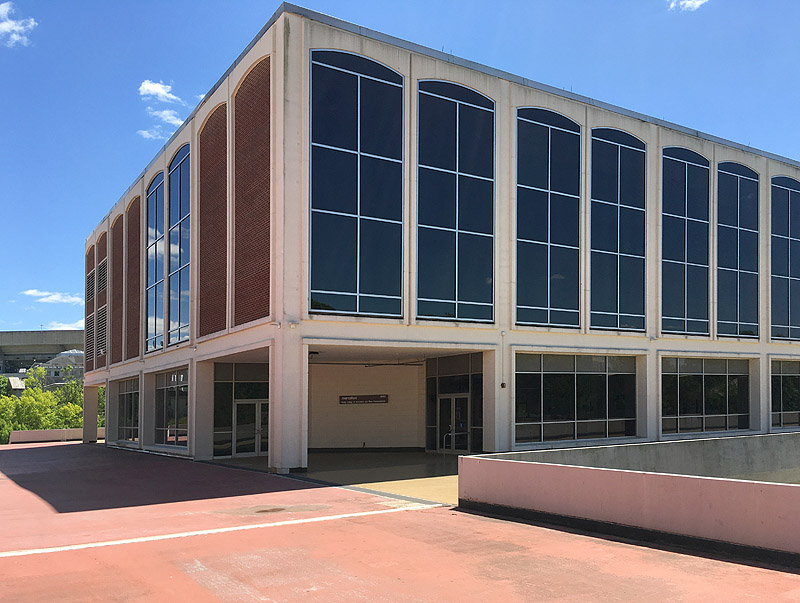
The Journalism building on P-J Plaza in 2021.
The upper storey was originally all red brick, as part of the left side still is.
Brick walls on the upper storeys were replaced with large windows in 2010.
For an older picture of P-J Plaza, scroll down.
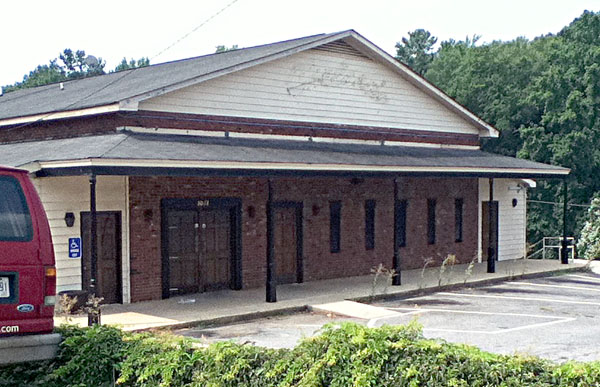
Former site of Pizza Inn, 2011. It is little changed today, except that it has
been used by a Christian ministry, and the neon sign from the strip joint has been
taken down.
Pizza Inn was on Baxter Street, in a building that later became a strip joint
and is now vacant. I've written about it here.
It's the first place I ever treated Melody to a meal.
If I were rich, I would open up a pizza place there again, just to redeem it from its
sullied past.

Aderhold Hall, housing the College of Education, in 2021 (the trees were much
shorter in 1976). The north side of the building is never in sunlight.
"Play with the computers" meant that we went to a tiny office that I then occupied on
the fifth floor of Aderhold Hall, where I was a student worker for the Department
of Business Education. The Urbana (Illinois) PLATO system was very famous
and is well remembered; more
about it here and here.
PLATO was an online community that strongly prefigured the Internet of twenty or thirty
years later. The terminal was a big box with an orange-on-black screen
and used an acoustical coupler, maybe at a speed higher than the usual 300 baud;
I wasn't sure. But we didn't succeed in using it that day.
Instead, I used a CRT terminal to access the University's CYBER 70/74.
I thought it was a CDC 713 but can't find a picture of a 713 anywhere on the Internet.
It looked very much like the CDC CC609 depicted at
this link.
It used a
black-and-white TV-type tube (bluish-gray on black).
I think I remember that the screen was oriented vertically (taller than it was wide),
but I can find no record that CDC made a terminal that way.
I don't know if it had an addressable cursor, but we certainly had no software that
used it as anything other than a glass teletype.
A session running BASIC would have looked rather like this
(not filling the whole screen, of course):
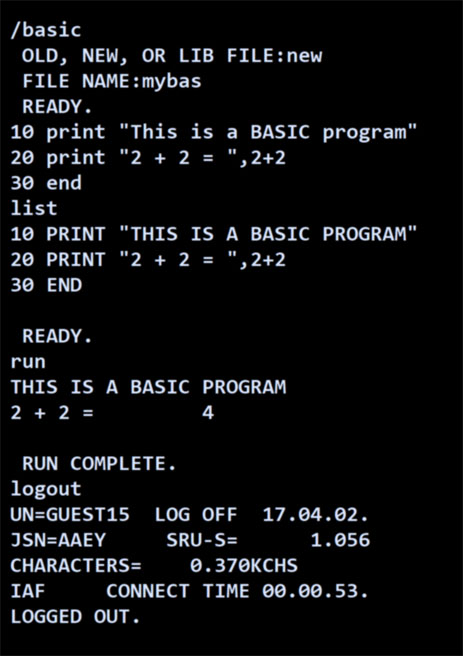
We were connected to the same computer that I matched wits with
on the day I met Melody.
See also this page, notes from the last time I used
a CYBER, in 2004.
There are apparently no longer any 60-bit CYBERs running anywhere in the world, but you can still
use an emulated 60-bit CYBER 170 (running on a PC!) at
Cray-CYBER.org.
That is the organization whose real CYBER I used in 2004.
Bear in mind that in 1976, almost nobody except computer specialists had seen anything like this.
A year later, Apple and others would get everybody using personal computers but not yet.
We were relying on mainframes. I was aware of micros, and had received (with my subscription),
and foolishly lent out and didn't get back, the 1975 Popular Electronics Altair issue,
but I had not even used a microcomputer myself.
Nonetheless, I worked for several professors who were avid proponents of educational computing
and could see what was coming. BASIC on the CYBER followed in the Dartmouth tradition
and prefigured how computing would look on the first micros.
This was the first time Melody had seen any computer programming done;
certainly not the last!
[UPDATE:] Searching my archives of color slides, I found pictures of the tiny office
where we played with computers. This was taken a few months earlier; the big box-like
PLATO terminal is
not there yet. The CDC CRT is on a cart at the side;
my dim recollection was that when Melody came, it was on the desk.
In the picture, what you see on the desk is the Selectric 1 typewriter that I used
to write documentation. The office was the corner of a classroom that had two doors,
walled off temporarily with bookcases so that one door was the office entrance.
Not everything in it was mine; I don't know what the movie reels, or maybe tapes,
on the right-hand side were for.
But here it is!
|

|
| |
Also, if you're wondering what scenery we saw from the 6th floor of the library,
I can show you. This is, again, a color slide taken (I think) a few months earlier.
You can see P-J Plaza in all its glory, and you can see that the stadium wasn't as big
as it is now.
Over the years, I have enjoyed watching the growth of the campus from that vantage point.

Photo by Michael Covington, 1975 or 1976
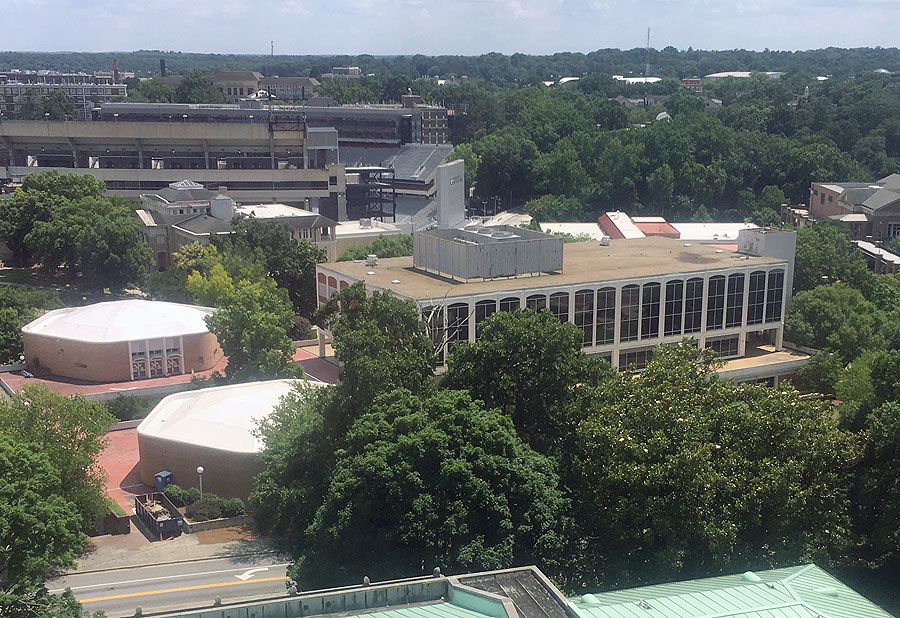
Photo by Michael Covington, 2021
From a window slightly to the left of the
one used in the original picture. The middle of the south side of the 6th floor
is now an office.
Permanent link to this entry


|
|
|
This is a private web page,
not hosted or sponsored by the University of Georgia.
Copyright 2021 Michael A. Covington.
Caching by search engines is permitted.
To go to the latest entry every day, bookmark
http://www.covingtoninnovations.com/michael/blog/Default.asp
and if you get the previous month, tell your browser to refresh.
Portrait at top of page by Sharon Covington.
This web site has never collected personal information
and is not affected by GDPR.
Google Ads may use cookies to manage the rotation of ads,
but those cookies are not made available to Covington Innovations.
No personal information is collected or stored by Covington Innovations, and never has been.
This web site is based and served entirely in the United States.
In compliance with U.S. FTC guidelines,
I am glad to point out that unless explicitly
indicated, I do not receive substantial payments, free merchandise, or other remuneration
for reviewing or mentioning products on this web site.
Any remuneration valued at more than about $10 will always be mentioned here,
and in any case my writing about products and dealers is always truthful.
Reviewed
products are usually things I purchased for my own use, or occasionally items
lent to me briefly by manufacturers and described as such.
I am no longer an Amazon Associate, and links to Amazon
no longer pay me a commission for purchases,
even if they still have my code in them.
|
|























